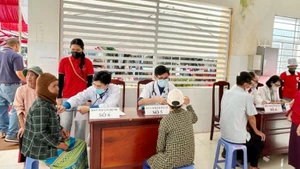According to the department, as of October 10, Rwanda in East Africa had recorded 58 cases of Marburg virus infection, with 13 deaths. Notably, 70% of the cases involved healthcare workers.
The disease caused by the Marburg virus is considered dangerous due to its high transmission and fatality rates, which can reach up to 88%. Currently, there is no vaccine or specific treatment available.
In Vietnam, the disease is classified as a Category A infectious disease under the Law on Prevention and Control of Infectious Diseases.
Several countries, such as the United States, China and the Republic of Korea, have strengthened medical measures at border checkpoints to control the spread of the Marburg virus.
To proactively detect the potential entry of Marburg into Vietnam, the General Department of Preventive Medicine has issued an urgent notice to the Pasteur Institute, International Health Quarantine Centres and Centres for Disease Control (CDC) of cities and provinces to focus on implementing detection and control measures for the disease.
International Health Quarantine Centres and CDCs in each city and province must update information on countries or regions currently reporting Marburg cases. Health officials are also instructed to closely monitor individuals requiring medical quarantine from these areas entering, transiting or importing goods through Vietnam's borders.
The agencies must also ensure that healthcare staff and those in contact with suspected or confirmed cases follow personal protective measures to prevent infections among healthcare workers and the wider community.
Temporary quarantine areas must also be prepared at border checkpoints for suspected or confirmed cases, if necessary. Health officials are asked to ensure that equipment, disinfectants and medications are ready for immediate use in the event of an outbreak. Training should be provided to health quarantine personnel for monitoring and controlling Marburg, with a particular focus on infection prevention and control measures.
Communication efforts at border checkpoints should continue, informing travellers and the public about preventive measures. People are required to report to healthcare facilities immediately if they develop symptoms or have been exposed to potential risk factors related to Marburg within 21 days of entering Vietnam.
Staff at border checkpoints should review and update their contingency plans for responding to potential Marburg outbreaks, in collaboration with local health authorities and other relevant agencies. This should include arrangements for healthcare staff, transportation of suspected or confirmed cases and identification of healthcare facilities capable of providing care and treatment.
The Ministry of Health has directed the Pasteur Institute and Epidemiology Institute to train and support localities in collecting and safely transporting medical samples. They are also responsible for receiving samples to confirm Marburg cases from localities, enhancing testing and diagnostic capacities and reviewing and reinforcing their rapid response teams to be ready for suspected or confirmed cases at the local level.
Dr Do Duy Cuong, Director of the Centre for Tropical Diseases at the Hanoi-based Bach Mai Hospital, said that the Marburg virus is in the same family as the Ebola virus. It is transmitted to humans through fruit bats, which act as intermediary hosts.
People can become infected if they come into contact with or inhale secretions or urine from these bats.
Marburg virus can also spread between humans through close contact and bodily fluids, including blood, urine, saliva, vomit, breast milk, semen or amniotic fluid. The virus may also be transmitted in laboratory settings or when healthcare workers care for infected patients. However, Marburg is not easily transmissible. It primarily spreads through direct contact. Transmission through respiratory droplets can occur but only with very close contact.
The clinical signs of Marburg virus disease are difficult to diagnose as they can be confused with other endemic diseases in the region. For example, in African countries, it can be mistaken for conditions like typhoid, yellow fever or Ebola, he said.
The disease's incubation period typically ranges from two to 21 days. Initially, patients may experience symptoms such as sudden fever, chills, headaches, muscle pain and body aches. By the fifth day of illness, a rash or burning sensation may develop. Other symptoms may include chest pain, abdominal pain, nausea, sore throat, diarrhoea and jaundice (yellowing of the eyes).
Patients may also present with bleeding or delirium and eventually go into shock, which can lead to liver failure, multiple organ failure and death. Currently, there is no specific vaccine or antiviral medication available to treat Marburg virus disease. Patients must be strictly isolated.
The primary method of treatment is supportive care, including measures such as managing bleeding and restoring electrolyte balance. In cases of multiple organ failure, patients may require oxygen and intensive care. Due to its high fatality rate, patients with Marburg virus disease often have a poor prognosis.
















